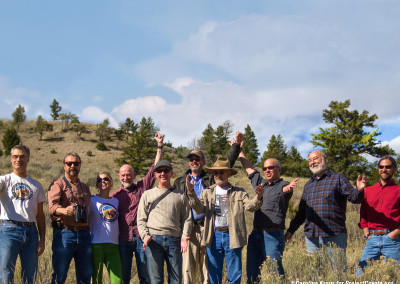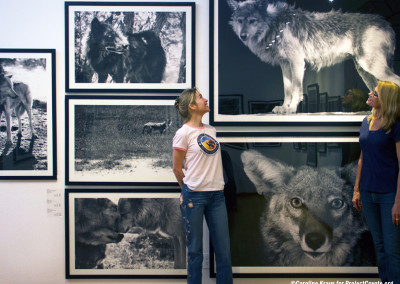Contact us if you would like to use any of these images for your publication or for outreach efforts. Project Coyote has a number of images available for use. Wildlife photographers provide us with images to use, that are copyrighted and will require prior approval. Wildlife enthusiasts have also made their images available through creative commons.
PHOTOS: WILDLIFE
CLICK ON ANY PHOTO TO START SLIDESHOW
Science Advisory Board
Our science advisory board, which includes some of the most renowned canid and conservation biologists and ecologists in the world, is on the front lines advocating for a new approach to carnivore conservation.
© Caroline Kraus
Guardian Dog Looks After Sheep
Guardian animals, such as this Great Pyrenees dog, have proven successful in reducing predation on livestock in a program in Marin County.
© Keli Hendricks
Coyote In Snow
A coyote walks through snow near Yellowstone National Park. The coyote population in the area has seen a decrease following the reintroduction of wolves to the park.
© Camilla H Fox
Keeping It Wild Youth Program
Students of the “Green Team” from Manor Elementary School in Fairfax spoke in favor of a ban on bobcat trapping before the California Fish and Game Commission.
© Project Coyote
Coyote Walking Across Rocks
Coyotes have a long, bushy, black-tipped tail that is usually carried pointed down. Usually grayish brown with reddish tinges behind the ears and around the face, coloration of coyotes can vary from silver-gray to black.
© Wally Nussbaumer
Coyote Visits Backyard
Our homes can offer an abundance of food, water, and shelter for coyotes. If you frequently see a coyote in your yard, make loud noises with pots, pans, or air horns, and haze the coyote with a water hose.
© Peggy Faranda
Coyote Pups Emerge From Their Den
Coyotes have proven resilient to attempts to eradicate them from the landscape. Lethal control methods include killing pups in their dens.
© Kees Hollemans & Iris van Noort
Coyote Profile
Western coyotes typically weigh 18 to 30 pounds and look similar to a small Shepherd or collie-type dog but have longer, denser fur and pointed, erect ears.
© Wally Nussbaumer
Bobcat at the Forest Edge
Though the bobcat prefers rabbits and hares, it will hunt anything from insects, chickens, geese and other birds and small rodents to deer. Prey selection depends on location and habitat, season, and abundance.
© Melissa Groo
Coyote Spotted Visiting Backyard
If you often spot a coyote in your backyard you should check that you are not unintentionally providing food for it by leaving pet food out, letting fruit fall or using a bird feeder.
© Peggy Faranda
The Gray Fox of Western America
The most abundant wild carnivores, foxes are found on every continent except Antarctica. The Gray Fox pictured here is the dominant fox species in the Pacific states.
© Bill Leikam
Coyote Looking Up
Hazing means scaring a coyote away and by doing so we can reinforce a coyote’s natural instinct to avoid people without harming them.
© Peggy Faranda
Installing Foxlights on Ranch
Technology like the foxlights being installed on Barboni Ranch help to deter predators during the night.
© Caroline Kraus
Smiling Coyote
About 95% of all of the behaviors we know of domestic dogs also occur in coyotes. Family oriented animals, they express emotions socially.
© Jaymi Heimbuch
Bobcat Rolling Over
Like most cats, the bobcat is territorial and largely solitary. About twice as large as the domestic cat. It has distinctive black bars on its forelegs and a black-tipped, stubby tail, from which it derives its name.
© Melissa Groo
Coyote Pups
Coyote pups are usually born in April and are raised by their parents. Around the end of the year, young coyotes will disperse.
© Kees Hollemans & Iris van Noort
Coyote Retreats to Cover
Coyotes are usually wary of people and will avoid us whenever possible. Check out our tips for coexistence if you regularly see coyotes near your home.
© Pirjo Pellon
North America’s Song Dog
Coyotes are usually heard at night but here a coyote communicates with its pack during the day.
© Wally Nussbaumer
Reforming Predator Management
Ttraps are often set under the guise of predator management and are indiscriminate in their choice of victims with family pets and endangered species regularly being ensnared.
CC-BY-NC-Travis-TrapWithFoot
Coyote Pups at Den Site
Reproduction is generally limited to the group’s leaders, while other females remain behaviorally sterile. 4-8 pups are born each season with an average of 50-70% dying within their first year.
© Sandy Sisti
Seeing eye-to-eye
Whether you live in a rural or urban area, you can help to educate your community about coyotes and coyote coexistence strategies.
© Pirjo Pellon
Coyote in Snow
As scavengers, coyotes provide an ecological service by helping to keep environments clean of carrion (dead things).
© Sam Parks
Big Otis Looks After Sheep
Big Otis guards sheep as part of the successful Marin County Livestock & Wildlife Protection Program that helps ranchers and predators peacefully coexist.
© Keli Hendricks
Mountain Lion in the Snow
Mountain lions are present on the west end of Charles M. Russell National Wildlife Refuge and a study is currently underway to learn more about these big cats.
CC BY 2.0 USFWS
Coyote in one of its Natural Habitats
Coyotes occupy a broad range of habitats and play an important ecological role in helping to maintain healthy ecosystems and species diversity.
© Sam Parks
Coyote Pair In Snow
Coyotes are generally monogamous, with pair bonds frequently lasting for many years, and some for life.
© Sam Parks
Black Bear Hunts for Berries
Black bears are omnivores with their diets varying greatly depending on season and location. They typically live in largely forested areas but will sometimes visit residential areas in search of food. © Deb Etheredge
Artists For Wild Nature
A catalyst for meaningful change, the power of art lies in its ability to transcend and inspire and to guide us past established realities and prevailing ideologies.
© Caroline Kraus
Coyote Hunting
A coyote looks under rocks in search of food. They are true omnivores, and will eat a wide variety of foods, including rodents, rabbits, insects, lizards, snakes, vegetables, and fruits.
© Wally Nussbaumer
Llama Stands Guard
Llamas are being used in Marin County as guardian animals for flocks of sheep in an effort to protect both livestock and native wildlife.
© Camilla H Fox
Mountain Lion Takes a Rest
Mountain lion lounging in a cottonwood tree during the heat of the day near Golden, Colorado.
CC BY 2.0 USFWS
Marcia Barinaga Ranch Guardian Great Pyrenees
Ranchers are increasingly combining centuries old animal husbandry techniques, like using guard dogs, with new technology like foxlights and electric fences to peacefully coexist with native wildlife.
© Camilla H Fox
Coyote In Spring
Coyotes limit mesocarnivore (skunks, raccoons, and foxes as well as feral cats) populations and increase bird diversity and abundance through competitive exclusion.
© David Parsons
Keeping It Wild Program Fosters Attitudes of Coexistence in Youth
Youth Outreach Associate, Grant McComb with friends rally for the protection of wolves in California as an endangered species.
© Project Coyote




































